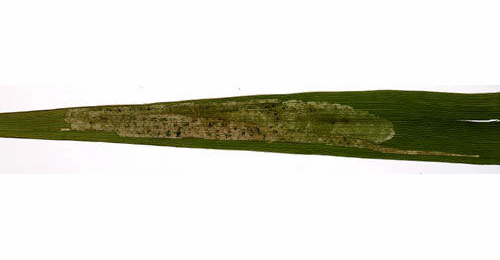|
||||||
|
AGROSTIS. Bents. [Poaceae] |
|
About twenty-six species of Agrostis are recorded in Britain. These include the native Velvet Bent (A. canina), Common Bent (A. capillaris), Black Bent (A. gigantea) and Creeping Bent (A. stolonifera). Twenty British miners are recorded on Agrostis. Nearly 100 British miners or possible miners are recorded on grasses in Britain. A key to the European miners recorded on Agrostis is provided in Bladmineerders van Europa. It is recommended that adults of all miners on grasses be reared to be certain of their identity. |
Key for the identification of the known mines of British |
Note: Diptera larvae may live in a corridor mine, a corridor-blotch mine, or a blotch mine, but never in a case, a rolled or folded leaf, a tentiform mine or sandwiched between two more or less circular leaf sections in later instars. Pupation never in a cocoon. All mining Diptera larvae are leg-less maggots without a head capsule (see examples). They never have thoracic or abdominal legs. They do not have chewing mouthparts, although they do have a characteristic cephalo-pharyngeal skeleton (see examples), usually visible internally through the body wall. The larvae lie on their sides within the mine and use their pick-like mouthparts to feed on plant tissue. In some corridor miners frass may lie in two rows on alternate sides of the mine. In order to vacate the mine the fully grown larva cuts an exit slit, which is usually semi-circular (see Liriomyza huidobrensis video). The pupa is formed within the hardened last larval skin or puparium and as a result sheaths enclosing head appendages, wings and legs are not visible externally (see examples). See Key to non-Diptera. |
1a > Leaf-miner: Larvae feed singly, forming an upper surface linear-blotch mine. Pupation either internal or external, with the puparium loosely glued to the leaf (Spencer, 1976: 91). Oviposition near the leaf margin, at some distance from the leaf tip. From there develops an upper-surface corridor-blotch. At first the mine ascends as a narrow corridor towards the leaf tip, then the direction turns and the mine, steadily widening, descends in the direction of the leaf base. Frass irregular, in rather coarse grains. Larva solitary. Pupation mostly outside the mine; in that case the puparium often sticks to the leaf. |
 Mine of Agromyza albipennis on Phalaris arundinacea Image: © Willem Ellis (Bladmineerders van Europa) |
|
Agromyza albipennis Meigen, 1830 [Diptera: Agromyzidae]. |
1b > Leaf-miner: Larvae feeding singly, forming a long, widening mine on the upper surface of the leaf, which is generally limited to one side of the leaf. Pupation external, puparium glued to the leaf near the end of the mine (Spencer, 1976: 128). Broad corridor, generally beginning near the leaf margin or close to the leaf tip. Most of the times the mine remains at one side of the midrib. The mine is upper-surface, but has some full depth, translucent spots here and there. Frass in rather regularly scattered grains. Pupation outside the mine. According to Dempewolf (2004a) only the male genitalia enable a reliable discrimination from A. abipennis and A. graminicola. |
|
|
Scaptomyza graminum (Fallén, 1823) [Diptera: Drosophilidae]. |
1d > Leaf-miner: In the first instar the larva mines the leaves, forming short, irregular, blotch-like mines, but in later instars it lives externally, feeding in spun leaves and often twisting those of tender shoots. Larval head light-brown or yellowish brown, edged with black postero-laterally, ocellar area blackish; prothoracic plate black edged with whitish anteriorly; abdomen dull dark green; pinacula distinct, black, sometimes brownish but with black bases to setae; anal plate large, black (Bradley et al., 1973). Small, full depth mine without a definite shape; little frass. Some silk is deposited in the mine. The larva soon leaves the mine and continues feeding among spun leaves. |
|
Cnephasia incertana (Treitschke, 1835) [Lepidoptera: Tortricidae] |
| Last updated 30-Jun-2019 Brian Pitkin | ||
